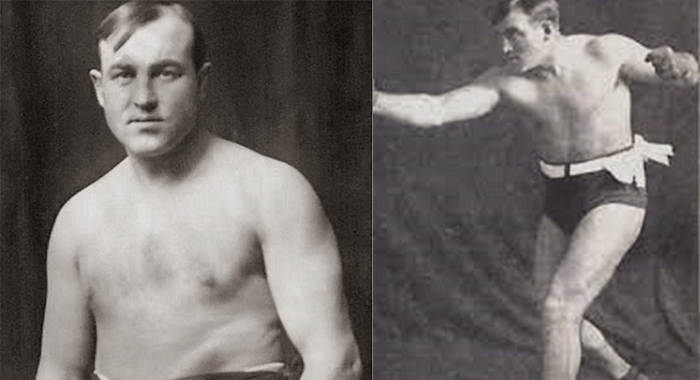NO. 1 TOMMY BURNS
What Burns lacked in height he made up for with quickness and pluck. The French-Canadian, whose real name was Noah Brusso, defeated bigger men by moving inside to inflict damage and then getting out quickly to avoid it.
That’s how he beat the sub-6-foot, but heavier Marvin Hart to win the heavyweight title by decision in 1906 in Los Angeles. Burns made several defenses and then took his championship belt on a successful world tour, finishing his title run with eight consecutive knockouts.
Disaster loomed, though. Following him on much of that tour was Jack Johnson, whose goal was to lure Burns into the ring. Johnson finally convinced Burns to fight him on Dec. 26, 1908 in Sydney. A $30,000 payday for Burns, the most ever earned by a boxer to that point, made it impossible to say no. Police halted Johnson’s slaughter of Burns, who officially lost a decision. He still has the distinction of being the shortest heavyweight champion.

NO. 2 MIKE TYSON
One amazing aspect of Iron Mike’s success was that he was dwarfed by most of his opponents. That certainly didn’t stop him from riding roughshod through the heavyweight division in the 1980s.
As the quick-handed, oh-so-powerful wrecking machine stopped one opponent after another to capture the imagination of the world. The 20-year-old phenomenon was 27-0 (25 KOs) when he stopped Trevor Berbick in less than two rounds to become the youngest ever to win the heavyweight championship.
Tyson’s reign wasn’t long. He was only 23 when Buster Douglas shocked him and the world by stopping the seemingly unbeatable force of nature in 10 rounds in 1990. Tyson was never the same. He went to prison after he was convicted of rape, returned to become a title holder for a short time, gnawed off a portion of Evander Holyfield’s ear and then declined rapidly. No one will forget what he accomplished or the excitement he generated.

NO. 3 (TIE) JOHN L. SULLIVAN
The Boston Strong Boy has evolved into a legend but he was a flesh-and-blood person. Those who were pummeled by him would tell you that if they were alive. Sullivan wasn’t tall but he was a thick, strong 190 pounds. And while he wasn’t the most-skillful boxer by today’s standards, his use of brute force was effective.
Indeed, as the story goes, he boasted, “I can lick any sonofabitch in the house.” And, by God, he could. He started the chain of lineal heavyweight champions in the late 1880s, the exact opponent and date being up for debate. What’s not in doubt was the night he lost his championship.
Sullivan agreed to defend his title against James J. Corbett on Sept. 7, 1992 in New Orleans. Corbett was a newfangled sort of fighter, a boxer who relied as much on guile as strength. Sullivan simply didn’t have the tools to compete with such a technician and was stopped in 21 rounds. He never fought again.

NO. 4 (TIE) ROCKY MARCIANO
Marciano had only an 8½-year career but he sure made a strong impression. The Brockton Blockbuster was known for his uncommon conditioning, resilience and power in spite of his short stature.
He fought as light as 178 pounds – which is unthinkable for a heavyweight today – but many of his opponents weren’t much heavier. He had a reach of only 68 inches, one more than Manny Pacquiao. Still, Marciano pounded his way through the heavyweight division and into title contention by the end of the 1940s, which was a quick ascent given that he turned pro in 1947 after learning to box in the Army.
He received a shot at heavyweight champion Jersey Joe Walcott in 1952. And he almost blew it. He was behind on points when he landed arguably the biggest punch ever, a right to the jaw that put Walcott to sleep and gave Marciano the belt. He successfully defended six times and then walked away, never having tasted defeat.

NO. 5 ROY JONES JR.
The supremely gifted Roy Jones Jr. was untouchable between 1989 and 2003, having dominated virtually every opponent he faced between 160 and 175 pounds. He suffered his only loss during that period to Montell Griffin when he was DQ’d for landing a punch while Griffin was down and later avenged the setback.
Jones wanted to do something even more extraordinary. And he did, challenging John Ruiz for his heavyweight title on March 1, 2003 in Las Vegas. It wasn’t close. Jones, who methodically bulked up to 193 pounds but retained plenty of his speed, gave the gritty, but limited Ruiz a boxing lesson to win a wide decision and claim a major belt.

Jones might’ve paid a price for his triumph. Many speculate that the weight gain and subsequent weight loss so he could fight again at 175 ruined his body. He was stopped by Antonio Tarver two fights later and was never quite the same. But he’ll always have that heavyweight belt.
